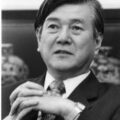Shake off “COVID self-restraint”! How about a healing stroll around a museum?—With the Scrolls of Frolicking Animals and Humans now on display, here’s our guide to viewing art followed by an enjoyable garden stroll.
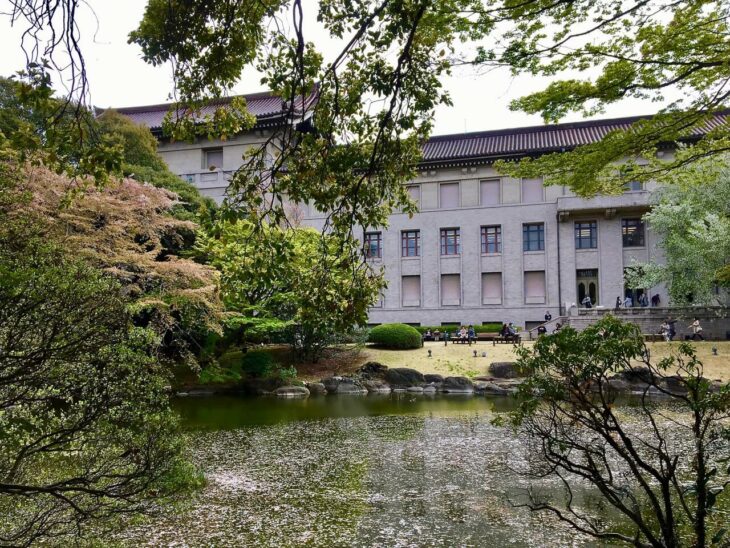
Tokyo National Museum in Ueno Park, Tokyo
Photo: The Japan Journal
Editor’s note: This article was written in March, before an increase in COVID-19 infections. However, we have obtained permission from the author and the publisher to reproduce this article unchanged now, when the COVID-19 pandemic has subsided again.
Kageyama Yumiko, antique art dealer and writer

Kageyama Yumiko
In any age, works of art enrich the hearts of those who see them. Right now, as we are worn out by living with COVID self-restraint, a single painting can provide energy and help us forget time spent in sadness.
Although some museums and galleries are currently closed due to COVID-19, others have carefully put in place infection control measures such as pre-booking and temperature checks, and are welcoming art fans. What’s more, as long as visitors wear masks and avoid crowded places, they can view art works in freedom.
As a collector of paintings by the mid-Edo-period painter Ito Jakuchu (1716–1800), I visit museum exhibitions here and there to view the works put on display. Some are quite unmissable. Many are places where you can take a walk outside to enjoy a change of pace—and I’d like to introduce some of those magnificent museums here.
Although there’s no shortage of Japanese museums with works to move the heart, one museum with many famous works is the Tokyo National Museum. It boasts one of Japan’s leading art collections, with 120,000 items, including 89 national treasures and 648 important cultural properties—and it has the longest history of any Japanese museum.
On entering the main gate, you can see the main building some way off. It is made in concrete with a tiled roof, and is a blend of Japanese and Western architectural styles. In 2001, this was designated as an Important Cultural Property. In front of the main building is a garden featuring lawns and a pond at its center. A huge tulip tree (Liriodendron tulipifera) stands solemnly as a symbol of the museum. On it, each May clusters of lovely little white lily-like flowers bloom. It is pleasant to spend time sitting on a bench by the great tree and let oneself become excited about the art one will soon see.
In the Heiseikan building, which is behind the main building to the left, the National Treasure: Frolicking Animals special exhibition was held from April 13 to May 30. These picture scrolls, which date to the Heian or Kamakura periods (approx. late 8th to early 14th centuries) and have been passed down in Kyoto’s Kosan-ji temple, have been exhibited many times and each time are hugely popular. The scenes of people and anthropomorphized animals are drawn in a single shade of ink and in a brush style that flows with life. These lively movements and comical expressions never lose their interest, no matter how many times one sees them.
The famous scene of frogs and rabbits engaged in sumo wrestling is just a small part of the work. This time, all four scrolls—Ko-kan (scroll no. 1), Otsu-kan (scroll no. 2), Hei-kan (scroll no. 3), and Tei-kan (scroll no. 4)—measuring over 44 meters in total length, are on display in their entirety for the whole exhibition. Originally, picture scrolls would have been enjoyed by unrolling them by hand from right to left. So, in this exhibition visitors can recreate the original experience of viewing the scrolls. What’s more, the method of standing on a moving walkway to view the Ko-kan is an unprecedented idea.
The exhibition also brings together fragments that have been separated from the four scrolls and copies with scenes that disappeared from the main scrolls. It really is a precious chance to understand the whole story of the picture scrolls.
Many people head straight for home fully satisfied after spending plenty of time looking at the works, but I recommend strolling on to the garden behind the main building. This is a place visited only by those in the know. The garden is laid out around a lake and adorned with flowering plants that change with the seasons. In April, you can enjoy Oshima cherry (Prunus speciosa) and in May, azaleas. Even just a quick walk around the garden offers a little taste of Japanese “forest bathing.” And if you sit on the recently installed stone seats, you’ll get a view of the whole garden.
There are five tea rooms dotted around the garden. They all have a special history, including the Kujokan which was originally a room from the Kujo-tei in the Kyoto Imperial Palace, and Okyokan, which has a connection with the mid-Edo-period painter Maruyama Okyo (1733–1795). The tea rooms can be hired for general use and are used for various things, including haiku poetry gatherings and tea ceremonies. In most cases museum tea rooms are only used for tea ceremonies, but these can be used by adults enjoying their hobbies.
The Nezu Museum — a place for lovers of flowers
A museum with a wonderful garden can also be found in a corner of the hyper-fashionable area of Omotesando, Tokyo. Walk ten minutes from Omotesando Station and an eye-catching building and bamboo thicket will appear. It is the Nezu Museum, which was rebuilt in 2009 to a design by the architect Kuma Kengo.
The early modern industrialist Nezu Kaichiro 1st (1860–1940), known as the “Railway King,” was active in the business world, but he also took the tea master name Seizan and was familiar with the tea ceremony. He had a passion for antiques from an early age and was a hugely ambitious collector of tea utensils and antique works of art. At the time, there were many auctions of items belonging to noble families, and Kaichiro over and again outbid others with high prices for famous items.
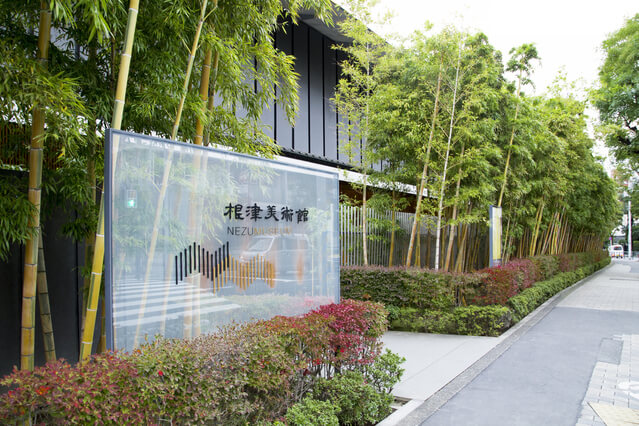
Nezu Museum in Minami-Aoyama, Tokyo
Yet, Kaichiro wasn’t the kind of speculative collector you see so often in today’s art world. Back then, Japan was in crisis with a flood of art works such as tea utensils, Japanese swords, and Buddha statues going overseas. So, Kaichiro and other business leaders actively collected and preserved famous works as a social duty. And he didn’t just secretly store his collection. Instead, he generously put on show his famous Japanese masterpieces with a wish “to enjoy them alongside many other people.”
One particularly famous work among these is Kakitsubata-zu byobu (Irises) by Ogata Korin (1658–1716). It is exhibited annually around the time that the kakitsubata (Japanese iris) blooms. From 17 April to May 16 in 2021, a special exhibition titled “The National Treasure Irises Screens” was held to celebrate the 80th anniversary of the museum’s opening.
These folding screens are by Ogata Korin, who was active during the 17th century in the early Edo period. They are a masterpiece that portray irises using lazurite (ultramarine) and verdigris (green) on a background of gold leaf squares in a sharp and dynamic composition. Only the irises are depicted.
Another example of Korin’s work depicts Yatsuhashi bridge (an eight-planked bridge) as well as irises. It is said that this “eight planked bridge”—a zigzag bridge made of narrow planks joined end to end—is, according to one explanation, where the Kyoto sweet called yatsuhashi got its name. Korin’s work evokes a scene from Ise Monogatari (The Tale of Ise) in which Ariwara no Narihira (825–880) is traveling to Togoku (the modern-day Kanto region) from Kyoto and, while on an eight-planked bridge in Mikawa province (modern-day eastern Aichi Prefecture), sees irises and thinks of his lover. However, in this picture the bridge is not depicted. It may be that Korin didn’t draw the bridge because he imagined the picture-viewer standing on top of it.
After you’ve had fun pondering that, next comes the Japanese garden. Here, real Japanese irises will be waiting for you. This is a vast garden of varied height covering an area of more than 17,000 m2 with a pond at its center and four tea rooms dotted about. The irises grow thickly in a pond in front of the Konintei tea house.
Having viewed them, you can now go back and see more of Korin’s works. One set of irises has been blooming continuously on a golden screen for some 320 years… while in the garden irises are in vibrant full bloom before your eyes. How about comparing the two—back and forth between past and present, painting and reality—and reconfirming their allure? And when you are weary of walking, for a rest I also recommend the fully glass-walled museum café.
A fun foot spa at the Okada Museum of Art
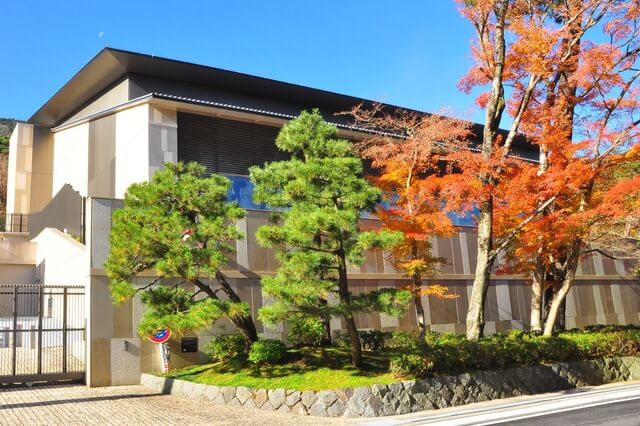
Okada Museum of Art in Kowakidani, Hakone, Kanagawa Prefecture
Photo: jooko3 / PIXTA
In the Kanagawa Prefecture city of Hakone, a place famous for its hot springs to relax body and soul, there is a rural hideaway-like museum. It’s the Okada Museum of Art in Kowakidani.
This new museum, which opened in 2013, is built on the site of the Kaikatei, a Meiji-period (1868–1912) hotel for Westerners. There is plenty to see in the collection, which mainly consists of early modern and modern Japanese paintings, as well as ceramics from Japan and other parts of the East. It’s even more healing than Hakone’s hot springs.
On entering the gate, to the left of the museum you’ll see a huge painting of the Wind God and the Thunder God. This work by Fukui Kotaro (1969–), a painter working in the traditional Japanese style, is named Wind/Time and measures 30 meters wide by 12 meters high. It is based on a national treasure, Wind God and Thunder God, by the early-Edo-period painter Tawaraya Sotatsu (1570–1643). It creatively reproduces that work on 640 gold leaf panels.
Sotatsu’s famous work Wind God and Thunder God depicts the two gods facing off in a gold leaf space. It’s well-known for the sculptural, massive, and mighty figures of the Wind God and Thunder God, as well as their dynamic and humorous appearance. Sotatsu’s work is depicted on a compact folding screen of three meters’ width by one-and-a-half-meter height, but Fukui’s work looks ten times bigger. Sky and clouds are reflected on Wind/Time through the glass that covers the panels, so it looks like the Wind God and Thunder God are flying about high in the Kowakidani sky. This sense of god-like energetic motion just has to be seen.
An exhibition was held at the museum from April 3 to September 26 called “Japanese Paintings from East to West: Taikan, Shunso, Shoen and more.” It is a chance to enjoy famous early-modern works, such as Reiho Ichimonji (Mt. Fuji), a huge nine-meter-wide painting by a master of Mt. Fuji depictions, Yokoyama Taikan (1868–1958), masterpieces by Uemura Shoen (1875–1949), and depictions of beautiful women by Kaburaki Kiyokata (1878–1972).
After you’ve visited the museum, I recommend a stroll in the garden, which has been designed to make use of Hakone’s natural environment. The garden has an area of 15,000 square meters, and peonies and hydrangeas are in full bloom from spring to early summer. It contains a restaurant, the Kaikatei, converted from an early-Showa-period (1926–1989) Japanese house. The udon noodles served with ingredients from ocean and mountain is a favorite, and the limited-quantity menu sometimes sells out.
Finally, relaxing in a foot spa is my own personal way to enjoy the museum. The spa is supplied directly from the spring source and is located in front of the huge Wind God and Thunder God painting. Standing right next to the work and looking up, it was so huge that I couldn’t take it all in. But viewing it from the foot spa a slight distance away, finally I was able to get a hold on the whole picture. You can order from a café menu too, so a fun thing I recommend is to hold a drink in one hand and enjoy watching the gods’ expressions change over time.
The many lesser-known attractions at the Nara National Museum
Another notable museum that is good for a stroll is the Nara National Museum in Nara Park. During the journey from Nara station to the museum, you’ll see idyllic scenes of deer relaxing. It’s a fun place to visit with much cultural heritage such as Kofuku-ji and Todai-ji temples.
From April 27, 2021, the museum held a special exhibition in the New East and West Wings to mark the 1,400th anniversary of the death of Prince Shotoku (574–622): “HORYUJI: Prince Shotoku and Treasures of Early Buddhist Faith in Japan.” This exhibition introduces temple treasures passed down in Horyu-ji temple, which was built by Prince Shotoku, and it is an opportunity to learn about Prince Shotoku as a person and the world of the Prince Shotoku cult. The cult of Prince Shotoku spread during the Heian period (794–1185), with Prince Shotoku himself worshipped as the reincarnation of Guze Kannon. The focal point of the exhibition is a famous statue, Prince Shotoku: The Seated Prince Shotoku, which is a national treasure from Horyu-ji Shoryoin. This statue is a temple principal object of worship and kept hidden from public view, so it is not normally exhibited. It was made for the 500th anniversary of Prince Shotoku’s death, and to see it in person on the 1,400th anniversary feels like a strange working of fate.
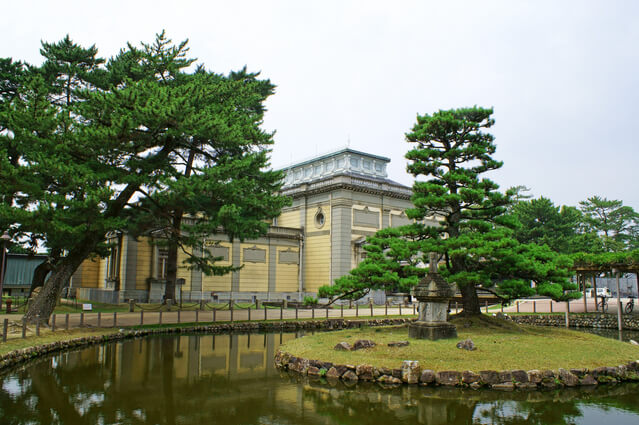
Nara National Museum in Nara Park
If you wish to enjoy a leisurely lunch or cup of tea in the vicinity of the museum, I recommend walking for about 13 minutes southwards to the restaurant of Fufu Nara, a luxury hotel by Sagiike pond. This small hotel only opened in June 2020. It is in a shady and relaxed spot that makes use of Nara’s historical yamatobari (overlapping wood panels), roof tiles, and Yoshino cedar, a strong timber with closely packed rings that is produced in the Yoshino forestry area of Nara Prefecture. If you drink tea while viewing the elegant garden with its bamboo groves and other features, your desire for art will be gently stimulated again.
And this area packed with famous spots also has a lesser-known garden. It is the Isui-en, located around six minutes’ walk north of the Nara Museum. The popular Todai-ji and Kofuku-ji temples are nearby, but the 3,400 tsubo (approx. 11,254 m2) garden is enveloped in a silence quite removed from its surroundings. It is Nara’s best-known chisen kaiyu style garden (a style of garden that features a path around a pond) and is designated as a National Site of Scenic Beauty. There are two gardens with different charms to enjoy: the front garden created during the Edo period (1603–1867) and the rear garden that was constructed in the Meiji period (1868–1912) to incorporate views of Mt. Wakakasa. The garden is also home to the Neiraku Museum of Art, where an exhibition titled “Meeting with Flowers” was held from April 7 to July 26, 2021, during the season of young flowers budding.
Shokoku-ji temple in Kyoto and the Jotenkaku Museum
Since I work as an antique dealer, I make frequent business trips to Kyoto. One place I always visit when I have time is Shokoku-ji temple and the Jotenkaku Museum located within its precincts. Shokoku-ji can be found to the north of the Kyoto Imperial Palace and is a famous temple of the Zen sect that was built by the third Muromachi shogun, Ashikaga Yoshimitsu (1358–1408). It is known for its connection with Ito Jakuchu.
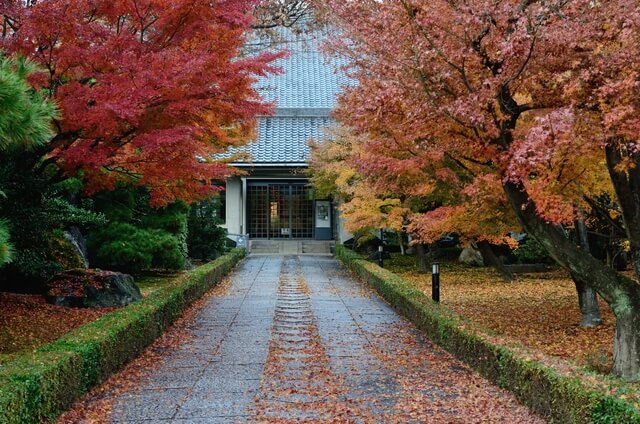
Jotenkaku Museum of Shokokuji temple, in Kyoto
Photo: Cphoto / PIXTA
The museum holds precious works such as temple treasures passed down not only in Shokoku-ji, but also Rokuon-ji (better known as Kinkaku-ji) and Jisho-ji (better known as Ginkaku-ji). Enter the gate and the beautiful mossy front garden will appear. There is a karesansui dry landscape garden typical of Zen temples, and you can also see the “Fudaraku-san (Potalaka Mountain)” garden laid out with Japanese sago palms. Fudarakusan is a legendary mountain said to be the home of Kannon Bosatsu. It’s a place to make you want to hold your hands in prayer.
The Jotenkaku Museum opened in 1984 as part of events to mark the 600th anniversary of Shokoku-ji’s founding. The exhibition space on the first floor was designed as a place to exhibit a total 33 scrolls, including the Shaka Sanzon-zo (Statues of Shakyamuni) and the Doshoku Sai-e (30 pictures of the Colorful Realm of Living Beings) donated to Shokoku-ji by Ito Jakuchu. At present, the Doshoku Sai-e are held by the Sannomaru Shozokan (The Museum of the Imperial Collections). Around the middle of the Meiji period, these were presented to the Imperial Household by Shokoku-ji when the temple faced difficulties due to an anti-Buddhist movement. Shokoku-ji then used the funds it received from the Imperial Household in return to buy back the extensive temple grounds that it still possesses. So, one can say that Jakuchu saved Shokoku-ji. The works temporarily came back home in 2007 for the Jakuchu Exhibition, 23 years after the museum’s opening. The Statues of Shakyamuni, meanwhile, were shown as part of the “Jakuchu Painting of the Edo Period” exhibition held from April 29 to July 25 and August 1 to October 24.
From inside the museum, you can look through a glass-paneled wall to get a giant panoramic view of the Jugyu no Niwa dry landscape garden. Jugyu no Niwa means “Garden of the Ten Bulls” and refers to bulls that represent the truth that is enlightenment in the Zen school of Buddhism. A bull herder represents the 10-step process of searching for and obtaining that truth. It’s fun to look at the garden and wonder what that process is.
At Shokoku-ji’s special spring viewing (held from March 24 to June 4), you can see the huge and impressive Hatto (Dharma Hall) remains from the Azuchi-Momoyama period (1573–1603), the beautiful dry landscape garden of the Hojo (Abbott’s chamber), and the white sand garden of the Kaizando (Founder’s Hall). There is plenty to see in these expansive temple precincts, so I recommend giving yourself plenty of time when you visit.
Japan’s foremost garden: the Adachi Museum
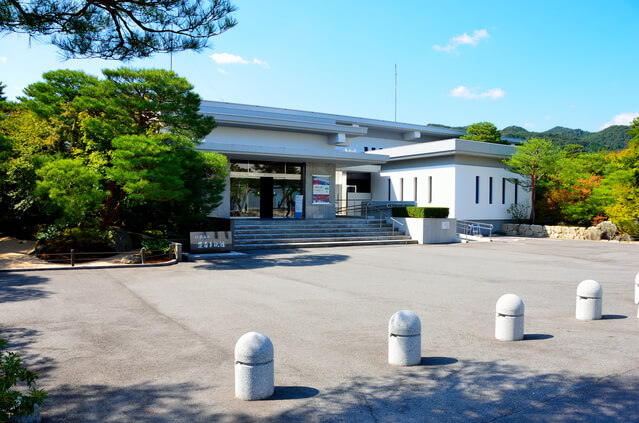
Adachi Museum in Shimane Prefecture
Lastly, I’ll explain about the Adachi Museum, which is located in Yasugi City, Shimane Prefecture.
It was opened in 1970 as a museum to view Japanese paintings and a Japanese garden, and it is based on art works collected by the local-born businessman Adachi Zenko (1899–1990). The garden that Zenko devised according to his own ideals and created has an area of 50,000 tsubo (approx. 165,500 m2). For 18 years in a row, it has been ranked Japan’s best garden by a specialist Japanese garden magazine published in the United States.
When you enter the museum the first thing to catch your eye will be the moss garden right in front of you. This side garden connects to the main dry landscape garden and it is as if a gentle curving line of moss invites you to the next garden. The dry landscape garden, which gives the feel of mountain and water, is made of stones and sand before a background of natural mountains. A mountain range in the distance and dry landscape garden are layered together to provide both panorama and depth. Next, the White Gravel and Pine Garden was painstakingly designed by Zenko to express the image of the painting Beautiful Pine Beach by Yokoyama Taikan. Large and small pines are positioned on gentle hills of white sand, providing a striking contrast between white and green. On the mountain beyond can be seen the Kikaku Waterfall, the motif for Taikan’s famous ink painting Waterfall in Nachi.
In accord with Zenko’s concept of “The garden is also a picture,” window frames in the museum are made to look like a picture frame (“Living Framed Painting”) and hanging scroll (“Living Hanging Scroll”), isolating specific scenes for viewing. That’s the idea behind such window frames. When you look through a museum window out to the garden it really does look like a painting.
The exhibition rooms have changing exhibitions of early modern to modern Japanese paintings, such as masterpieces by Takeuchi Seiho (1864–1942) and Uemura Shoen, as well as ceramics by Kitaoji Rosanjin (1883–1959). At any one time, you can see around 20 of 120 masterpieces by Yokoyama Taikan collected by Zenko with passionate enthusiasm, so it’s a must-see for Taikan fans.
And the garden is a wonderful display of seasonal beauty, making it somewhere I recommend visiting spring, summer, autumn and winter.
References:
Kosan-ji, Frolicking Animals https://kosanji.com/chojujinbutsugiga/ (in Japanese)
Kyoto Imperial Palace https://sankan.kunaicho.go.jp/english/guide/kyoto.html
Nezu Kaichiro https://www.nezu-muse.or.jp/en/about/index.html
Kakitsubata-zu byobu (Irises) by Ogata Korin https://www.nezu-muse.or.jp/en/exhibition/past2021_n03.html
Wind God and Thunder God by Tawaraya Sotatsu https://www.kenninji.jp/gallery/#&gid=1&pid=1
Reiho Ichimonji (Mt. Fuji) https://www.okada-museum.com/en/collection/japanese_painting/japanese_painting12.html
Prince Shotoku from Prince Shotoku and Attendants https://www.narahaku.go.jp/english/exhibition/special/202104_horyuji/
Fufu Nara https://www.fufunara.jp/en/
Adachi Zenko https://www.adachi-museum.or.jp/en/about
Japanese Gardens of Adachi Museum of Art https://www.adachi-museum.or.jp/en/garden
Translated from “Korona jishuku wo futtobase! Kokoro wo iyashi ni bijutsukan wo aruko—Chojugiga kokai, aato kansho no atoni niwa mo tanoshimeru sansaku-kei wo goannai (Shake off “COVID self-restraint”! How about a healing stroll around a museum? —With the Scrolls of Frolicking Animals and Humans now on display, here’s our guide to viewing art followed by an enjoyable garden stroll),” Bungeishunju, May 2021, pp. 324–330. (Courtesy of Bungeishunju, Ltd.) [December 2021].
Keywords
- Kageyama Yumiko
- antique art dealer
- writer
- art
- museums
- gardens
- Scrolls of Frolicking Animals and Humans
- Tokyo National Museum
- Ito Jakuchu
- Nezu Museum
- Nezu Kaichiro
- Seizan
- Ogata Korin
- Irises
- Okada Museum of Art
- Hakone
- Fukui Kotaro
- Wind/Time
- Wind God and Thunder God
- Tawaraya Sotatsu
- Nara National Museum
- Prince Shotoku
- Horyu-ji
- Isui-en
- Shokoku-ji
- Jotenkaku Museum
- Adachi Museum
- Adachi Zenko
- Yokoyama Taikan

